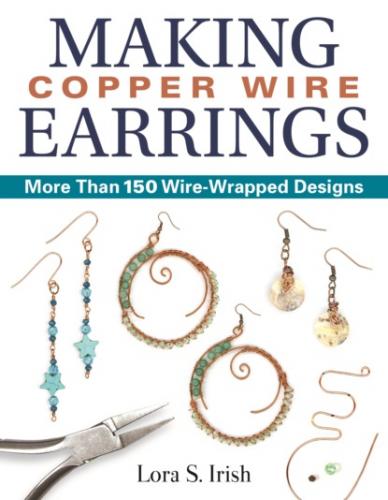2 The outer face of an end cutter is curved so that only the cutting edge touches the wire. This tool allows you to clip the wrapped loops parallel to the main wire.
3 Side cutters are heavy-duty cutting tools, able to handle thick-gauge wire, like 16-gauge and thicker, easily.
The flat, outer side of a pair of flush cutters is placed against the jewelry piece, with the V-shaped inner cutting edge facing away from the finished project.
Side cutters have a very deep V-shape on the inner cutting edge. The outer edge also carries this V-shape. The final cut will carry the V-shape and may need extra sanding to smooth the cut wire end.
CHAIN-NOSE AND BENT-NOSE PLIERS
Chain-nose and bent-nose pliers ensure you keep a firm grip on the wire you’re working with. You should have a pair of chain-nose pliers as well as a pair of bent-nose pliers.
4 Chain-nose pliers are available with smooth inner gripping surfaces or finely textured inner surfaces that give greater gripping power. Be careful, though: textured inner surfaces can leave fine scratches on the wire.
5 This particular pair of chain-nose pliers includes a handy side cutter at the base of the pliers’ arms, allowing it to do double duty.
6 Bent-nose pliers have special angled noses that allow them to get into tight, hard-to-reach areas. Like chain-nose pliers, they are available with smooth or textured gripping surfaces.
The flat inner surface of any pair of straight pliers allows you to create crisp, angular bends, like the right-angle bend shown here.
Bent-nose pliers have curved noses that can allow for a more flexible grip and angle of approach for tricky wraps.
ROUND-NOSE PLIERS
Round-nose pliers allow you to create perfect round shapes and curves because both arms are cone-shaped to provide a graduated surface on which you can bend circular elements. If you only have a budget for one pair of round-nose pliers, make it a medium-sized, smooth pair.
7 Smooth-surfaced round-nose pliers do not mar or damage the wire as you turn loops.
8 Textured round-nose pliers have cone-shaped arms that are textured with a fine grit pattern. The extra texture makes bending heavy-gauge wires easy but can potentially mar delicate metals.
9 Round-nose pliers are available in a variety of sizes—from extra small for creating tiny jump rings, like this pair, to extra large for creating miniature hoops.
Where you position the wire in the graduated, cone-shaped arms of a pair of round-nose pliers will determine the diameter of the circle you are creating. Close to the tip results in smaller loops; close to the base results in larger loops.
Round-nose pliers can be used to create U-bends, end loops, and mid-wire circles (as shown here).
NYLON-JAW PLIERS
10 A pair of nylon-jaw pliers will make working with spooled wire frustration-free and is an essential part of your toolkit. These straight, wide-armed pliers have a nylon pad that prevents the pliers from scarring the wire. Whenever you use a new wire, pull it through a pair of nylon pliers first to ensure that the working wire is straight and without the small bends that naturally occur from being wrapped on the spool. Roll off a length of wire from the spool, grip the wire close to the spool with the pliers, and then pull the pliers to the end of the wire.
As you can see on this pair of pliers, the nylon pads on some nylon-jaw pliers can be replaced if the pads become damaged over time.
Because of their extra-wide surface, nylon-jaw pliers are perfect for gripping very large curves, spirals, and bends as you work earring links.
FILES, HAMMERS, AND ANVILS
A file is essential for ensuring your earrings are clean and polished. Hammers and anvils, while not essential, will allow you to diversify the effects you create in your earrings.
11 Sandpaper, nail files, and metal files are a great part of any jewelry kit. Use them to remove the small wire burrs that can occur when a wire is cut and to smooth the ends of cut wires.
12 Ball-peen hammers have a slight curve to the hammer’s face that allows you to evenly bend a wire into three-dimensional shapes as well as flatten wire into varying thicknesses. Ball-peen hammers leave small indents, giving a textured finish to the flattened wire.
13 Jeweler’s anvils only measure about 3" (7.5cm) long. The top anvil pictured here has a textured surface that adds small, fine indents to hammered wire. The second anvil is smooth-surfaced.
14 A nylon mallet or plastic head mallet has a dense, smooth plastic head that leaves no scratches, lines, or indents in hammered metal.
Visual texture is an important part of wire-wrapped jewelry. You can add extra texture to wire links by laying the wire link on an anvil and then tapping the link with a ball-peen hammer or nylon mallet.
WIRE-WRAPPING SPECIALTY TOOLS
There are a variety of specialty tools designed just for making wire-wrapped jewelry. These are fun additions to any jeweler’s toolkit, but they are not strictly necessary for the techniques you will be learning in this book.
15 Wire-wrapping pliers is a general term that applies to many different styles of pliers with variously shaped jaws. You may find use for any of them. For example, shown here is a set of pliers that has one flat, straight arm and one cone-shaped arm. This tool makes perfect small loops as well as square-angled
